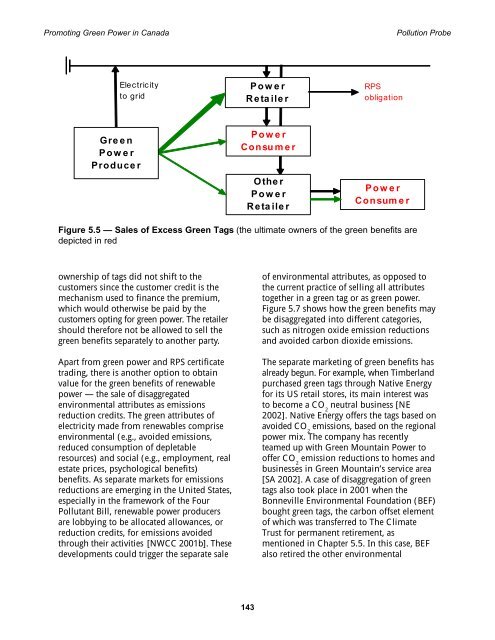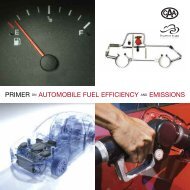Promoting Green Power in Canada - Centre for Human Settlements
Promoting Green Power in Canada - Centre for Human Settlements
Promoting Green Power in Canada - Centre for Human Settlements
- No tags were found...
You also want an ePaper? Increase the reach of your titles
YUMPU automatically turns print PDFs into web optimized ePapers that Google loves.
<strong>Promot<strong>in</strong>g</strong> <strong>Green</strong> <strong>Power</strong> <strong>in</strong> <strong>Canada</strong> Pollution ProbeElectricityto grid<strong>Power</strong>RetailerRPSobligation<strong>Green</strong><strong>Power</strong>Producer<strong>Power</strong>ConsumerOther<strong>Power</strong>Retailer<strong>Power</strong>ConsumerFigure 5.5 — Sales of Excess <strong>Green</strong> Tags (the ultimate owners of the green benefits aredepicted <strong>in</strong> redownership of tags did not shift to thecustomers s<strong>in</strong>ce the customer credit is themechanism used to f<strong>in</strong>ance the premium,which would otherwise be paid by thecustomers opt<strong>in</strong>g <strong>for</strong> green power. The retailershould there<strong>for</strong>e not be allowed to sell thegreen benefits separately to another party.Apart from green power and RPS certificatetrad<strong>in</strong>g, there is another option to obta<strong>in</strong>value <strong>for</strong> the green benefits of renewablepower — the sale of disaggregatedenvironmental attributes as emissionsreduction credits. The green attributes ofelectricity made from renewables compriseenvironmental (e.g., avoided emissions,reduced consumption of depletableresources) and social (e.g., employment, realestate prices, psychological benefits)benefits. As separate markets <strong>for</strong> emissionsreductions are emerg<strong>in</strong>g <strong>in</strong> the United States,especially <strong>in</strong> the framework of the FourPollutant Bill, renewable power producersare lobby<strong>in</strong>g to be allocated allowances, orreduction credits, <strong>for</strong> emissions avoidedthrough their activities [NWCC 2001b]. Thesedevelopments could trigger the separate saleof environmental attributes, as opposed tothe current practice of sell<strong>in</strong>g all attributestogether <strong>in</strong> a green tag or as green power.Figure 5.7 shows how the green benefits maybe disaggregated <strong>in</strong>to different categories,such as nitrogen oxide emission reductionsand avoided carbon dioxide emissions.The separate market<strong>in</strong>g of green benefits hasalready begun. For example, when Timberlandpurchased green tags through Native Energy<strong>for</strong> its US retail stores, its ma<strong>in</strong> <strong>in</strong>terest wasto become a CO 2neutral bus<strong>in</strong>ess [NE2002]. Native Energy offers the tags based onavoided CO 2emissions, based on the regionalpower mix. The company has recentlyteamed up with <strong>Green</strong> Mounta<strong>in</strong> <strong>Power</strong> tooffer CO 2emission reductions to homes andbus<strong>in</strong>esses <strong>in</strong> <strong>Green</strong> Mounta<strong>in</strong>’s service area[SA 2002]. A case of disaggregation of greentags also took place <strong>in</strong> 2001 when theBonneville Environmental Foundation (BEF)bought green tags, the carbon offset elementof which was transferred to The ClimateTrust <strong>for</strong> permanent retirement, asmentioned <strong>in</strong> Chapter 5.5. In this case, BEFalso retired the other environmental143
















